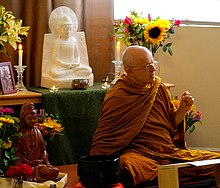Mettā Forest Monastery
| Mettā Forest Monastery | |
|---|---|
| Religion | |
| Affiliation | Thai Forest Tradition |
| Location | |
| Location | 13560 Muutama Lane Valley Center, CA 92082 |
| Country | United States |
| Geographic coordinates | 33°19′34″N 117°02′07″W / 33.3261°N 117.0353°W |
| Architecture | |
| Founder | Ajaan Suwat Suvaco |
| Completed | 1990 |
| Website | |
| http://www.watmetta.org/ | |
Mettā Forest Monastery, also known as Wat Mettāvarānaṁ or Wat Mettā, is a Theravāda monastery in Valley Center, California. It was founded in 1991 by Ajaan Suwat Suvaco (1919–2002) along with his student Ṭhānissaro Bhikkhu. Ajaan Ṭhānissaro has been the resident abbot since 1993.[1]: 178 [2]: 40 Currently there are ten resident bhikkhus, nine American bhikkhus and one Thai,[3] as well as space for lay Buddhists on overnight retreat.[4]: 103

Ajaan Ṭhānissaro stresses the importance of strict adherence to the Vinaya or Buddhist monastic code which teaches relying only on donations from the lay community as well as living in the wilderness, a key feature of the Thai Forest Tradition of which he is a part.[1]: 178 All visitors are expected to follow the Eight Precepts of Buddhism, which helps introduce students into the practice of Theravāda Buddhism.[5]
Historical Context
[edit]Even though the Mettā Forest Monastery has not been widely studied, the founding of this monastery is of great importance in establishing Theravāda Buddhism within the United States. Part of the problem of recognizing Buddhism in the US is that many surveys do not allow participants to select their specific school of Buddhism, so it is hard to know how many Theravāda Buddhists there are in the US.[6]
Theravāda Buddhism was only introduced in the US in the late 1960s, much later than when Buddhism was first established in the country.[7] There was an increase of temples being built in the 1980s and 1990s, with Mettā Forest being one of fourteen established in California in the 1990s.[8] The Mettā Forest Monastery was founded thanks to a generous donation of land from someone from Massachusetts, with the expectation that a monastery would be built there.[9] These wishes were carried out as the monastery now draws Buddhists from the surrounding California area. Theravāda Buddhism is practiced in many different ways across the US; congregating in monasteries is just one way to practice Buddhism,[8] and the Mettā Forest Monastery invites laypeople to connect to their religion and community.
See also
[edit]- Theravāda Buddhism
- Thai Forest Tradition
- Ajaan Suwat Suvaco
- Ṭhānissaro Bhikkhu
- Buddhism in the United States
- Buddhist monasticism
- Eight Precepts
References
[edit]- ^ a b Seager, Richard Hughes (2012). Buddhism in America. Columbia University Press. ISBN 978-0-231-15972-2. OCLC 753913907.
- ^ Cadge, Wendy (2009). Heartwood : the First Generation of Theravada Buddhism in America. The University of Chicago Press. ISBN 978-0-226-08901-0. OCLC 781261340.
- ^ "Home | Metta Forest Monastery". www.watmetta.org. Retrieved October 10, 2022.
- ^ Mitchell, Scott A. Buddhism in America global religion, local contexts. ISBN 978-1-4725-8192-1. OCLC 1075716868.
- ^ Gomes, Jacquetta (May 2004). "The development and use of the eight precepts for lay practitioners, Upāsakas and Upāsikās in Theravāda Buddhism in the West". Contemporary Buddhism. 5 (1): 47–63. doi:10.1080/1463994042000249535. ISSN 1463-9947. S2CID 145757479.
- ^ "Perfection and Liberation: Buddhaghosa and the Theravadin Tradition of Self-Renunciation", Pneumatology and the Christian-Buddhist Dialogue, BRILL, pp. 131–158, January 1, 2012, doi:10.1163/9789004231245_007, ISBN 9789004231245, retrieved November 7, 2022
- ^ Cadge, Wendy (2004). Heartwood : the first generation of Theravada Buddhism in America. Chicago: University of Chicago Press. ISBN 978-0-226-08901-0. OCLC 527729874.
- ^ a b Cadge, Wendy; Sangdhanoo, Sidhorn (May 2005). "Thai Buddhism in America: an historical and contemporary overview". Contemporary Buddhism. 6 (1): 7–35. doi:10.1080/14639940500129421. ISSN 1463-9947. S2CID 143930238.
- ^ Roether, Barbara. "Exile Spirit". Tricycle: The Buddhist Review. Retrieved November 7, 2022.
Further reading
[edit]- "Our Trip to the Metta Forest Monastery in California"
- Bhikkhu, Thanissaro. "The Customs of the Noble Ones."
- Bretfeld, Sven. "Theravāda Buddhism." Oxford Research Encyclopedia of Religion. 29 Jul. 2019
